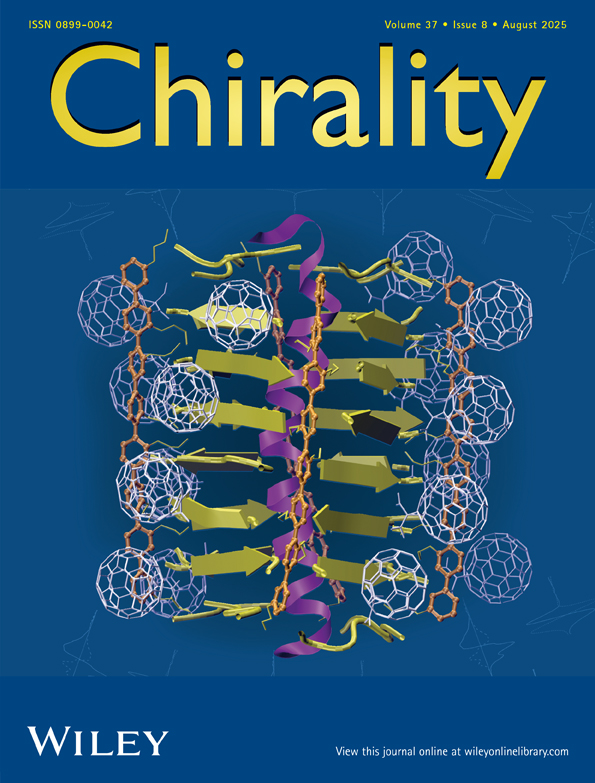First synthesis and resolution of a planar-chiral tetrahydroindolyl complex of iron: Electronic tuning of reactivity and enantioselective nucleophilic catalysis
Michinori Suginome
Department of Chemistry, Massachusetts Institute of Technology, Cambridge, Massachusetts
Search for more papers by this authorCorresponding Author
Gregory C. Fu
Department of Chemistry, Massachusetts Institute of Technology, Cambridge, Massachusetts
Department of Chemistry, 77 Massachusetts Avenue, Room 18-411, Cambridge, MA 02139-4307Search for more papers by this authorMichinori Suginome
Department of Chemistry, Massachusetts Institute of Technology, Cambridge, Massachusetts
Search for more papers by this authorCorresponding Author
Gregory C. Fu
Department of Chemistry, Massachusetts Institute of Technology, Cambridge, Massachusetts
Department of Chemistry, 77 Massachusetts Avenue, Room 18-411, Cambridge, MA 02139-4307Search for more papers by this authorAbstract
The first examples of an (η5-indolyl)iron complex and of an (η5-tetrahydroindolyl)iron complex are described. Reactivity studies establish that the (η5-tetrahydroindolyl)iron complexes are the most active azaferrocene-derived nucleophilic catalysts reported to date and that the reactivity of these complexes can be electronically tuned. Use of planar-chiral, enantiopure (η5-3-(dimethylamino)tetrahydroindolyl)FeCp* in asymmetric catalysis leads to stereoselectivities comparable to those furnished by a previously described azaferrocene complex. Chirality 12:318–324, 2000. © 2000 Wiley-Liss, Inc.
LITERATURE CITED
- 1(a) Togni A, Hayashi T, editors. Ferrocenes. New York: VCH; 1995, and references therein. (b) Noyori R. Asymmetric catalysis in organic synthesis. New York: Wiley; 1994.
- 2Ruble JC, Fu GC. Chiral π-complexes of heterocycles with transition metals: a versatile new family of nucleophilic catalysts. J Org Chem 1996; 61: 7230–7231.
- 3(a) Ruble JC, Latham HA, Fu GC. Effective kinetic resolution of secondary alcohols with a planar-chiral analogue of DMAP. Use of the Fe(C5Ph5) group in asymmetric catalysis. J Am Chem Soc 1997; 119: 1492–1493.Ruble JC, Tweddell J, Fu GC. Kinetic resolution of aryl alkyl carbinols catalyzed by a planar-chiral derivative of DMAP: a new benchmark for nonenzymatic acylation. J Org Chem 1998;63:2794–2795. Tao B, Ruble JC, Hoic DA, Fu GC. Non-enzymatic kinetic resolution of propargylic alcohols by a planar-chiral DMAP derivative; crystallographic characterization of the acylated catalyst. J Am Chem Soc 1999;121:5091–5092. (b) Liang J, Ruble JC, Fu GC. Dynamic kinetic resolutions catalyzed by a planar-chiral derivative of DMAP: Enantioselective synthesis of protected α-amino acids from racemic azlactones. J Org Chem 1998; 63: 3154–3155. (c) Ruble JC, Fu GC. Enantioselective construction of quaternary stereocenters: rearrangements of O-acylated azlactones catalyzed by a planar-chiral derivative of 4-(pyrrolidino)pyridine. J Am Chem Soc 1998; 120: 11532–11533. (d) Hodous BL, Ruble JC, Fu GC. Enantioselective addition of alcohols to ketenes catalyzed by a planar-chiral azaferrocene: catalytic asymmetric synthesis of arylpropionic acids. J Am Chem Soc 1999; 121: 2637–2638.
- 4(a) Dosa PI, Ruble JC, Fu GC. Planar-chiral heterocycles as ligands in metal-catalyzed processes: enantioselective addition of organozinc reagents to aldehydes. J Org Chem 1997; 62: 444–445. (b) Lo MM-C, Fu GC. A new class of planar-chiral ligands: the synthesis of a C2-symmetric bisazaferrocene and its application in the enantioselective Cu(I)-catalyzed cyclopropanation of olefins. J Am Chem Soc 1998; 120: 10270–10271. (c) Qiao S, Fu GC. The first application of a planar-chiral phosphorus heterocycle in asymmetric catalysis: enantioselective hydrogenation of dehydroamino acids. J Org Chem 1998; 63: 4168–4169.
- 5(a) For reviews of the chemistry of DMAP, see: Scriven EFV. 4-Dialkylaminopyridines: super acylation and alkylation catalysts. Chem Soc Rev 1983; 12: 129–161. (b) Hassner A, Krepski LR, Alexanian V. Aminopyridines as acylation catalysts for tertiary alcohols. Tetrahedron 1978; 34: 2069–2076. (c) Höfle G, Steglich W, Vorbrüggen H. New synthetic methods. 25. 4-Dialkylaminopyridines as acylation catalysts. 4. Puridine syntheses. 1. 4-Dialkylaminopyridines as highly active acylation catalysts. Angew Chem, Int Ed Engl 1978; 17: 569–583.
- 6For a discussion, see: Cirrincione G, Almerico AM, Aiello E, Dattolo G. Aminopyrroles. In: RA Jones, editor. Pyrroles. New York: Wiley Interscience; 1992.
- 7For example, crystalline 3-aminoindole “can be stored without appreciable signs of decomposition for a long time”. See: Yarosh AV, Velezheva VS, Kozik TA, Suvorov NN. Derivatives of indole. CXIII. Synthesis and some properties of 3-aminoindole. Khim Geterotsikl Soedin 1977; 481–485.
- 8Pracejus H, Wallura G. Zur Kenntnis einiger arylierter Ketoketene J Prakt Chem 1963; 19: 33–36.
- 9Suvorov NN, Velezheva VS, Yarosh AV, Erofeev YV, Kozik TN. Indole derivatives. CVIII. Indole isocyanates and some synthesis involving them. Chem Heterocycl Compd (Engl Transl) 1975; 11: 959–964.
10.1007/BF00470499 Google Scholar
- 10Krimen LI. Acetic formic anhydride. Org Synth 1970; 50: 1–3.
- 11Bunel EE, Valle L, Manriquez JM. Pentamethylcyclopentadienyl acetylacetonate complexes of iron(II), cobalt(II), and nickel(II). Convenient synthetic entries to mono-η5-C5Me5 derivatives. Organometallics 1985; 4: 1680–1682.
- 12Pauson has suggested that (η5-indolyl)FeCp may be accessible, but he has not provided details: Pauson PL, Qazi AR. Metal complexes of heterocycles. II. N-pyrrolyl complexes of iron. J Organomet Chem 1967; 7: 321–324.
- 13For a study of the decomposition of azaferrocene, see: Efraty A, Jubran N, Goldman A. Chemistry of some η5-pyrrolyl- and η1-N-pyrrolyliron complexes. Inorg Chem 1982; 21: 868–873.
- 14(a) For η5 to η3 ring slippage of a cyclopentadienyl group, see: Schuster-Woldan HG, Basolo F. Kinetics and mechanism of substitution reactions of π-cyclopentadienyldicarbonylrhodium. J Am Chem Soc 1966; 88: 1657–1663. (b) For evidence that the indenyl ligand has a greater propensity than the cyclopentadienyl ligand to ring slip from η5 to η3, see: Hart-Davis AJ, Mawby RJ. Reactions of π-indenyl complexes of transition metals. I. Kinetics and mechanisms of reactions of tricarbonyl-π-indenylmethylmolybdenum with phosphorus(III) ligands. J Chem Soc (A) 1969; 2403–2407. Rerek ME, Ji L-N, Basolo FJ. The indenyl ligand effect on the rate of substitution reactions of dicarbonyl(η-indenyl)rhodium and tricarbonyl(η-indenyl)manganese. Chem Soc, Chem Commun 1983; 1208–1209. (c) For a review of ring slippage, see: O'Connor JM, Casey CP. Ring-slippage chemistry of transition metal cyclopentadienyl and indenyl complexes. Chem Rev 1987; 87: 307–318.
- 15For the hydrogenation of Fe(η5-indenyl)2 to Fe(η5-tetrahydroindenyl)2, see: Fischer EO, Seus DZ. Di-tetrahydroindenyl-eisen. Naturforsch 1954; 9b: 386.
- 16Selectivity factor = (rate of fast-reacting enantiomer)/(rate of slow-reacting enantiomer). For a review of kinetic resolution, see: Kagan HB, Fiaud JC. Kinetic resolution. Top Stereochem 1988; 18: 249–330.




